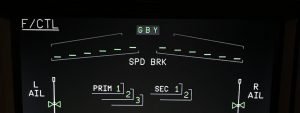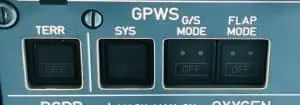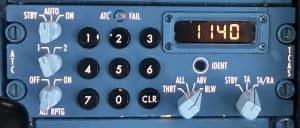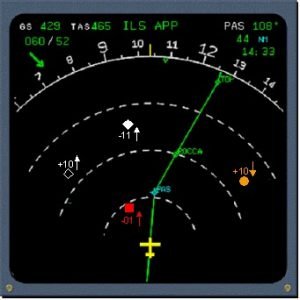
Pete has been flying aircraft for the last 20 years. He has flown everything from light piston aircraft up to heavy jets as both First Officer and Captain. He’s currently enjoying life flying the Airbus A330 for a major international airline.
A METAR (Meteorological Terminal Air Report) is a routine aviation weather report of actual observed conditions at an airport.
METARs report actual weather observed at an airport. METARs are encoded in a standard format that can be understood internationally. There are slight differences between North American and International METARs but the format is generally the same, with different units of measurements used.
Table of Contents
How do you decode a METAR?
Let’s take the following example of a METAR we’ve just picked up via ACARS for Chicago O’Hare International:
- KORD 021651Z 260/14kt 10SM FEW250 29/17 A2988 RMK AO2 SLP112 T02940167 $
- Station: e.g. KORD is Chicago.
- Issue time: 02165Z The date and the time the METAR was issued in UTC (also known as “Zulu” time), i.e. 021651Z means on the second day of the month, at 1651 Zulu time.
- Wind direction and speed: 260/14KT Wind direction in METARs is in degrees true (i.e. with reference to true north, as opposed to magnetic north). Wind speed is normally issued in knots, but can also be issued in “MPS” (meters per second). In this case the wind is from 260º True, at 14 knots.
- Visibility: In the U.S. visibility is measured in Statute Miles (SM) and feet. 10SM is a visibility of “10 Statute Miles or greater”).
- Cloud cover: FEW250 refers to few cloud at 25,000 feet.
Cloud cover is measured in “Oktas” or “eighths of the sky”.
Few (FEW) = 1-2 Oktas
Scattered (SCT) = 3-4 Oktas
Broken (BKN) = 5-7 Oktas (i.e. greater than half the sky)
Overcast (OVC) = 8 Oktas (i.e. the sky is fully obscured by cloud) - Temperature and dew point: 29/17 The temperature is reported first (in degree celsius) followed by the dew point (the temperature at which the air would become saturated with water vapor). The dew point is also reported in degrees celsius.
- Sea level pressure: A2988 Refers to an altimeter setting in inches of mercury which will show QNH (i.e. the elevation above sea level). In this case, setting 29.88 on the altimeter when at the gate in Chicago will show 668 feet (i.e. the elevation of Chicago O’Hare).
- RMK (Remarks): The remarks section can contain a number of different items. In this case AO2 tell us this METAR was recorded by an automatic station with a precipitation discriminator. SLP112 tell us the sea level pressure in millibars – in this case 1011.2mb. (A great explanation of SLP by David Werntz can be found here). T02940167 gives us more accurate temperature and dew point information: Temperature of 29.4ºC and dew point of 16.7ºC.
METAR Decode – Definitive List
| – | light | FRQ | frequent | RA | rain |
| + | heavy | FT | feet | RTD | routine delayed observation |
| $ | maintenance check indicator | FU | smoke (French: fumée) | RV | reportable value |
| ACC | altocumulus castellanus | FZ | freezing | RVR | runway visual range |
| ACFT MSHP | aircraft mishap | FZRANO | freezing rain sensor not available | RVRNO | RVR system values not available |
| ACSL | altocumulus standing lenticular cloud | G | gust | RWY | runway |
| ALP | airport location point | GR | hail (French: grêle) | S | south |
| ALQDS | all quadrants | GS | snow pellets and/or small hail (French: grésil) | SA | sand |
| ALQS | all quadrants | HLSTO | hailstone | SCSL | stratocumulus standing lenticular cloud |
| AO1 | automated station without precipitation discriminator | HZ | haze | SE | southeast |
| AO2 | automated station with precipitation discriminator | IC | ice crystals | SFC | surface |
| APCH | approach | INCRG | increasing | SG | snow grains |
| APRNT | apparent | INTMT | intermittent | SH | showers |
| APRX | approximately | KT | knots | SLP | sea-level pressure |
| ATCT | airport traffic control tower | LAST | last observation before a break in coverage at a manual station | SLPNO | sea-level pressure not available |
| AUTO | fully automated report | LST | local standard time | SM | statute miles |
| B | began at time | LTG | lightning | SN | snow |
| BC | pathches (French: bancs) | LWR | lower | SNINCR | snow increasing rapidly |
| BL | blowing | M | minus, less than | SOG | snow on the ground |
| BR | mist (French: Brume) | MAX | maximum | SPECI | an unscheduled special report following a significant change |
| CA | cloud-air lightning | METAR | routine weather report provided at fixed intervals | SQ | squall |
| CB | cumulonimbus cloud | MI | shallow (French: mince) | SS | sandstorm |
| CBMAM | Cumulonimbus mammatus cloud | MIN | minimum | STN | station |
| CC | cloud-cloud lightning | MOV | moved/moving/movement | SW | southwest |
| CCSL | cirrocumulus standing lenticular cloud | MT | mountains | TCU | towering cumulus |
| cd | candela | N | north | TS | thunderstorm |
| CG | cloud-ground lightning | N/A | not applicable | TSNO | thunderstorm information not available |
| CHI | cloud-height indicator | NE | northeast | TWR | tower |
| CHINO | sky condition at secondary location not available | NOSPECI | no SPECI reports are taken at the station | UNKN | unknown |
| CIG | ceiling | NW | northwest | UP | unknown precipitation |
| CONS | continuous | OCNL | occasional | UTC | Coordinated Universal Time |
| COR | correction to a previously disseminated observation | OHD | overhead | V | variable |
| DR | low drifting | OVR | over | VA | volcanic ash |
| DS | duststorm | P | greater than the highest reportable value | VC | in the vicinity |
| DSIPTG | dissipating | PCPN | precipitation | VIS | visibility |
| DSNT | distant | PK WND | peak wind | VISNO | visibility at secondary location not available |
| DU | widespread dust | PL | ice pellets | VR | visual range |
| DVR | dispatch visual range | PNO | precipitation amount not available | VRB | variable |
| DZ | drizzle | PO | dust (French: poussière) or Sand Whirls | W | west |
| E | east, ended at time, estimated ceiling | PR | partial | WND | wind |
| FC | funnel cloud | PRES | pressure | WS | wind shear |
| FG | fog | PRESFR | pressure falling rapidly | WSHFT | wind shift |
| FIRST | first observation after a break in coverage at manual station | PRESRR | pressure rising rapidly | Z | Zulu/UTC |
| FROIN | frost on the indicator | PWINO | precipitation identifier sensor not available | ||
| FROPA | frontal passage | PY | spray |
How long are METARs valid for?
METARs in the U.S. are valid for one hour and are issued hourly.
In other countries METARs are generally valid for 30 minutes and are issued twice per hour – at 20 minutes past the hour and 50 minutes past the hour.
If there are significant changes since the time a METAR was released a SPECI will be issued.
Related: Aviation SPECI Reports – A Pilot’s Guide
What does $ mean in a METAR?
The $ indicates maintenance is required on the automated system. Sometimes the RMK (remarks) section of the METAR will contain a maintenance status indicator.
METAR Maintenance Status Indicators
| METAR RMK | Sensor Failure |
| CHICO LOC | Ceiling height sensor |
| FZRABI | Freezing rain sensor |
| PNO | Rain gauge |
| PWINO | Present weather indicator |
| RVRNO | If RVR is missing and would normally be reported |
| TSNO | Lightning detection system |
| VISNO LOC | Secondary visibility sensor |
Aviation Flight Categories
In the U.S. METARs can be shorted to display the time of flying that is possible at an airport with respect to ceiling and visibility. The four aviation flight categories are:
- VFR: Visibility greater than 5 miles and ceiling greater than 3000 feet.
- Marginal VFR: Visibility between 3 and 5 miles and/or a ceiling between 1000 feet and 3000 feet.
- IFR: Visibility of 1 mile of more but less than 3 miles and/or a ceiling of 500 feet or more but less than 1000 feet.
- Low IFR: Visibility less than 1 mile and/or a ceiling less than 500 feet.
Trend Type Forecast
A trend type forecast, or simply a “trend” is a forecast valid for two hours appended to a METAR or SPECI.
An example of a trend type forecast: TEMPO 3SM VCSH = Temporarily visibility of 3 statute miles, with showers in the vicinity (between 5 and 10 SM of the airport).
What are the differences between METARs and TAFs?
A METAR is Meteorological Terminal Air Report (or “aviation routine weather report”) is a weather report of a actual conditions at an airport at a specific time.
A TAF (Terminal Area Forecast) is a weather forecast for a given area around the airport specified in the forecast.
Therefore the main difference between the two is that METARs are a record of actual conditions where TAFs are a prediction of future weather.
Another difference is that METARs may include a “remarks”(RMK) section. Remarks may include more accurate temperature, sea level pressure (SLP) or runway state group (for example if the runway is contaminated by snow).
TAFs, METARs and SPECIs use a common code to describe the weather such as TS for thunderstorms or SHRA for rain showers.
Frequently Asked Questions about METARs.
Are winds in METARs in degrees true or magnetic?
Wind direction in METARs and TAFs are in degrees true.
What does the term METAR mean?
A METAR (Meteorological Terminal Air Report) is a routine aviation weather report of actual observed conditions at an airport.
Where can you get METARs?
We can get METARS in many places, for example: if airborne we can receive them via ACARS/Datalink, they can be accessed online (for example at the NOAA Aviation Weather Center) or through apps such as ForeFlight or AeroWeather.
When are METARs issued?
In the United States METARs are usually issued once per hour, at 55 minutes past the hour. In other States they are often issued twice per hour, at 20 minutes past, and 50 minutes past the hour.
What does NSC in a METAR mean?
NSC stands for “No Significant Cloud” and is used if no clouds have been observed.
What does NCD in a METAR mean?
NCD stands for “no cloud discernible” and is issued if no cloud is detected by an automatic reporting station.
What is the meaning of NDV in a METAR?
NDV means No Directional Variation and is used when visibility has been recorded automatically by only one sensor. As only one sensor has been used it cannot detect any variation in the visibility
What does 9999 mean in a METAR?
9999 refers to a visibility of 10,000m or more.
What does a V mean in a METAR?
V means “variable” and refers to wind direction. For example, a METAR that reads 030/15 010V060 means the predominant wind is from 030º at 15 knots, variable in direction from 010º to 060º.
What is the difference between SKC and CLR?
Both SKC and CLR mean clear skies with SKC used by manual stations and CLR issued by automatic stations indicating no cloud layers detected at or below 12,000 feet.
What does VV or VV/// mean in a METAR?
VV refers to “vertical visibility” and means the sky is obscured by surface-based phenomenon (e.g. fog); the three digits that follow VV indicate the height in hundreds of feet. VV/// means the vertical visibility is of an indefinite height.
What does a P mean in a METAR?
A P indicates greater than the highest reportable value. For example, P6SM means a visibility of greater than 6 statute miles.
What is CAVOK in aviation weather?
CAVOK stands for “ceiling and visibility OK” and means no cloud below 5000 feet, no cumulonimbus (CB) or towering cumulus (TCU) at any level, and visibility 10 KM/6 SM or greater.
What is the meaning of VC in METARs?
VC stands for “vicinity” and refers to weather that is near the airport, but not at it. For example, VCSH means rain showers in the vicinity of the airport.
“Weather phenomena occurring beyond the point of observation (between 5 and 10 sm) are coded as in the vicinity (VC)” [FAA Advisory Circular -Aviation Weather Services 3.1.5.8.2]
Are cloud heights in METARs AGL or MSL?
METARs refer to heights above the airport, i.e. AGL.
What does SPECI mean in a METAR?
SPECI refers to a special update of a METAR when there has been a significant change since the METAR was issued. Find out more about SPECIs here.
How often are TAFs issued?
TAFs are issued 4 times a day, at 6-hourly intervals. 0500z, 1100z, 1700z and 2300z, and are valid for 30 hours.
What is a “ceiling” in aviation?
A ceiling is when the sky is obscured by five eighths (i.e. 5 octas) of the sky or more i.e. Broken (BKN) or Overcast (OVC) cloud.
When are TAFs issued?
TAFs are normally issued 4 times a day beginning at 0500Z and reissued every 6 hours (0500z, 1100z, 1700z, 2300z).
When are METARs issued?
METARs in the U.S. are generally issued once per hour on the hour, and internationally often twice per hour – at 20 minutes last the hour, and 50 minutes past.
Where can I get more information about aviation weather?
FAA Advisory Circular – Aviation Weather Services
Featured image: jvinals/Unsplash
If you found this article interesting please take 5 seconds to share this on your favorite social media. Thanks so much, I really appreciate it! [email protected]

Pete has been flying aircraft for the last 20 years. He has flown everything from light piston aircraft up to heavy jets as both First Officer and Captain. He’s currently enjoying life flying the Airbus A330 for a major international airline.






